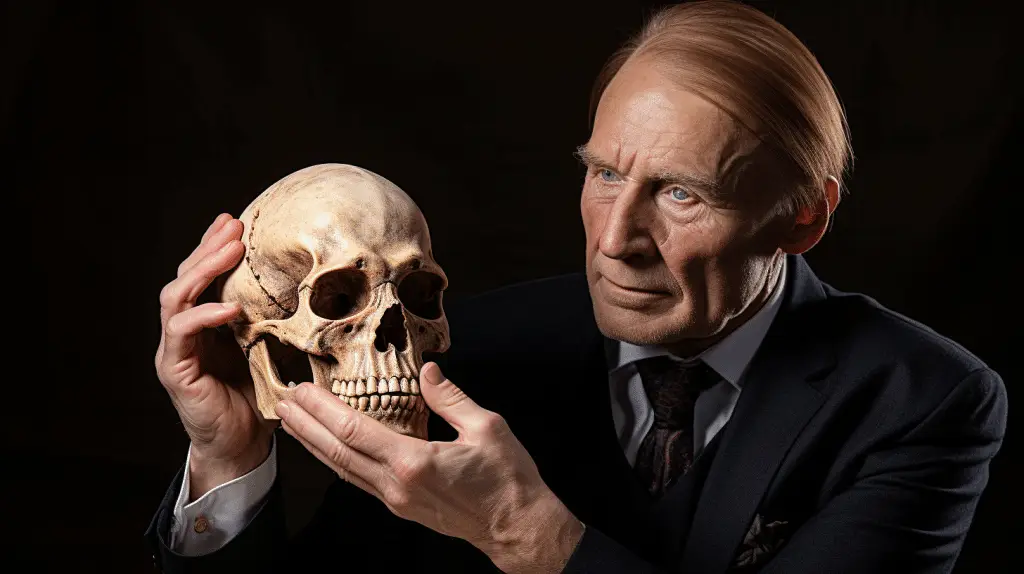The Piltdown Man Uncovered. Have you ever heard of the Piltdown Man? This proposed species of extinct hominid was discovered in England in 1910-12 and generated a controversy that lasted more than 40 years. It was later proved to be one of the most successful hoaxes in the history of science. The Piltdown Man was believed to be a crucial missing link in the evolution of humans, but it turned out to be a forgery.
The hoax began when amateur fossil hunter Charles Dawson discovered a skull in a gravel pit in Piltdown, England. He claimed that the skull belonged to a previously unknown species of human, which he named Eoanthropus dawsoni. The skull had a large braincase and an ape-like jaw, which led scientists to believe that the Piltdown Man was an early human ancestor. However, in 1953, it was revealed that the skull was a fake, made up of a human skull and an orangutan jaw.
The Piltdown Man hoax fooled the scientific community for some forty years before it was finally exposed. It was a major embarrassment for the field of anthropology and a cautionary tale about the importance of rigorous scientific investigation. Despite the hoax, the search for the missing link in human evolution continued, and new discoveries have shed light on our origins.
The Discovery of Piltdown Man

The Initial Find
In 1912, an amateur archaeologist named Charles Dawson claimed to have discovered a new species of extinct hominid in a gravel pit in Piltdown, East Sussex. The fossils he found consisted of a skull and jawbone that he believed belonged to a creature that was the missing link between apes and humans. The discovery was considered to be one of the most significant archaeological finds of the 20th century.
Charles Dawson and Arthur Smith Woodward
Dawson brought his findings to Arthur Smith Woodward, a paleontologist at the British Museum of Natural History. Woodward was initially skeptical of the discovery, but he was eventually convinced of the authenticity of the fossils. He named the new species “Eoanthropus dawsoni,” or “Dawson’s dawn man.”
Dawson and Woodward continued to excavate the site, and they uncovered more fragments of the skull and jawbone as well as stone tools and animal bones. They published their findings in several scientific journals, and the discovery quickly gained international attention.
However, as time passed, doubts about the authenticity of the Piltdown Man began to emerge. In 1953, new scientific techniques were used to analyze the fossils, and it was discovered that the skull and jawbone did not belong to the same individual. In fact, the skull was that of a medieval human, and the jawbone belonged to an orangutan.
The Piltdown Man was exposed as a hoax, and it remains one of the most infamous scientific frauds in history. Charles Dawson has been widely suspected of perpetrating the hoax, but the true identity of the perpetrator remains a mystery.
The Anatomy of the Hoax

The Piltdown Man hoax was one of the most infamous hoaxes in the history of science. It involved the fabrication of a human-like skull and jawbone that were presented as the missing link between humans and apes. The hoax was not discovered until 1953, more than 40 years after the initial discovery of the Piltdown Man fossils.
The Skull and Jaw
The skull fragments were found in a gravel pit in Piltdown, England, in 1908. The fragments were identified as belonging to a human skull and were estimated to be about 500,000 years old. The jawbone was found in the same location in 1912 and was identified as belonging to an ape. The skull and jawbone were combined to create the Piltdown Man.
The skull fragments were artificially stained to make them appear older than they actually were. The teeth were filed down to resemble those of a human. The jawbone was modified to fit the skull fragments. The combination of the skull and jawbone created a convincing fossil that appeared to be the missing link between humans and apes.
Teeth and Bones
The teeth and bones used in the hoax were from various sources. The teeth were from an orangutan, while the bones were from a human and an elephant. The bones were also artificially stained to make them appear older than they actually were.
The hoax was not discovered until 1953, when new dating techniques revealed that the skull fragments and jawbone were not from the same time period. The skull fragments were from a medieval human skull, while the jawbone was from an orangutan that lived in the 19th century.
In conclusion, the Piltdown Man hoax was a carefully orchestrated deception that fooled scientists for more than 40 years. The combination of a human skull and an ape jawbone created a convincing fossil that appeared to be the missing link between humans and apes. However, the hoax was eventually exposed, and the true origins of the skull fragments and jawbone were revealed.
The Role of Museums and Societies

When it comes to the Piltdown Man hoax, museums and societies played a significant role in both the propagation and eventual debunking of the fraud. Here we’ll take a closer look at the contributions of two prominent institutions: The Geological Society and The British and Natural History Museums.
The Geological Society
The Geological Society of London was one of the first organizations to publish information about the Piltdown Man discovery. In 1913, the society’s Quarterly Journal included a paper by Arthur Smith Woodward and Charles Dawson, the two men who claimed to have found the fossil. The paper described the skull fragments and jawbone that had been unearthed, and suggested that they belonged to a previously unknown species of early human.
The Geological Society continued to publish articles about Piltdown Man for several years, with many of its members expressing support for the discovery. However, as doubts began to emerge about the authenticity of the fossils, the society also played a role in investigating the matter. In 1953, a team of scientists from the society and the University of Oxford used fluoride dating to determine that the bones were not nearly as old as had been claimed.
The British and Natural History Museums
The British Museum and the Natural History Museum, both located in London, were also involved in the Piltdown Man saga. The British Museum acquired the original Piltdown Man skull fragments in 1912, and they remained on display there for many years. The Natural History Museum, meanwhile, had a cast of the skull that was used in many scientific studies.
Over time, both museums began to have doubts about the authenticity of the Piltdown Man fossils. In the 1930s, the British Museum even commissioned a scientific study of the bones. However, it wasn’t until the 1950s that conclusive evidence of the fraud was uncovered, thanks in part to the efforts of scientists at the Natural History Museum.
Throughout the Piltdown Man hoax, both museums and societies played an important role in shaping scientific opinion about the discovery. While they were initially supportive of the fossil, they also helped to expose the fraud and ensure that the truth about Piltdown Man was eventually revealed to the public.
Unraveling the Hoax

The Piltdown Man was one of the most notorious scientific hoaxes in history. It was believed to be the missing link between humans and apes, but it turned out to be a complete fraud. The hoax was finally exposed in 1953, but it took over 40 years to unravel the mystery.
Kenneth Oakley and Joseph Weiner
In 1949, Kenneth Oakley and Joseph Weiner used fluorine dating to prove that the Piltdown Man was a fake. They discovered that the skull was much younger than the jawbone, which was a clear indication that the two parts did not belong to the same individual. This was the first major breakthrough in the investigation.
The Cricket Bat Theory
In 1953, the Piltdown hoax was finally exposed when Sir Wilfrid Edward Le Gros Clark, a British anatomist, and Joseph Weiner, a physical anthropologist, discovered that the skull was actually that of a modern human, and the jawbone belonged to an orangutan. The bones had been stained with iron and chromic acid to make them look older, and the teeth had been filed down to make them look more human-like. The most shocking discovery was a small piece of wood embedded in the skull, which turned out to be a cricket bat.
Martin Hinton’s Role
Martin Hinton, a museum curator, played a crucial role in uncovering the Piltdown hoax. He had suspected that the Piltdown Man was a fake since the 1920s, but he was ignored by the scientific community. In 1949, he found a box of bones in a museum basement that had been labeled as “Piltdown-like.” He realized that the bones were the missing link that had been planted to support the hoax. Hinton’s discovery was the final nail in the coffin of the Piltdown hoax.
The Piltdown hoax was a major scientific fraud that fooled the scientific community for over 40 years. It was a cautionary tale about the dangers of confirmation bias and the importance of skepticism in scientific research. The Piltdown hoax has since become a symbol of scientific fraud, and it continues to be studied by scientists and historians alike.
The Impact on Science and Evolution

The Piltdown Man hoax had a significant impact on the scientific community and the study of human evolution. Here are some of the key ways in which it affected the field of anthropology and palaeontology:
The Missing Link
One of the most significant ways in which the Piltdown Man impacted the study of human evolution was through its supposed role as the “missing link” between apes and humans. The discovery was initially hailed as a major breakthrough in understanding human origins and was widely accepted by the scientific community. However, the hoax was eventually exposed, and the findings were discredited. This caused significant embarrassment and undermined the credibility of the scientific community.
Reconstruction and Species
The discovery of the Piltdown Man also had a significant impact on the reconstruction of early humans and the classification of species. The skull fragments and other bones that were found were used to construct a model of what the Piltdown Man might have looked like. However, the hoax meant that the reconstruction was based on false information, leading to incorrect assumptions about the evolution of early humans.
Impact on Anthropology and Palaeontology
The Piltdown Man hoax had a lasting impact on the fields of anthropology and palaeontology. It highlighted the importance of scientific rigor and the need for careful scrutiny of evidence. It also led to increased skepticism and caution among scientists, who were more careful to verify claims and evidence before accepting them as fact.
The discovery of the Piltdown Man was particularly significant because it came at a time when the scientific community was grappling with the implications of Charles Darwin’s theory of evolution. The hoax was seen as a blow to the credibility of evolutionary theory and raised questions about the validity of other discoveries related to human evolution.
Despite the negative impact of the Piltdown Man hoax, it also served as a cautionary tale about the importance of scientific integrity and the need to remain vigilant against fraud and deception in the scientific community.
International Reactions

Germany
When news of the Piltdown Man hoax broke in 1953, German anthropologist Otto Schoetensack was among the first to express skepticism about the authenticity of the fossils. Schoetensack had previously examined the remains and found them to be suspiciously modern-looking. He had also noted that the teeth did not match those of any known hominid species.
France
In France, the reaction to the Piltdown Man hoax was mixed. Some scientists were quick to dismiss the fossils as a forgery, while others remained convinced of their authenticity. At the Sorbonne, for example, a team of researchers led by Marcellin Boule continued to defend the Piltdown Man as a legitimate discovery until the 1930s.
United States
In the United States, the Piltdown Man hoax was met with a mixture of fascination and skepticism. Many American scientists were eager to study the fossils and contribute to the ongoing debate over their authenticity. One of the most vocal critics of the Piltdown Man was Franz Weidenreich, a German-born anthropologist who had emigrated to the United States in the 1920s. Weidenreich argued that the Piltdown Man was a composite of a modern human skull and an orangutan jaw.
Despite the skepticism of some scientists, the Piltdown Man remained a celebrated discovery for many years. It was not until the early 1950s that new techniques for dating fossils and analyzing their chemical composition revealed the truth about the hoax. Today, the Piltdown Man remains a cautionary tale about the dangers of scientific fraud and the importance of rigorous skepticism in the pursuit of knowledge.
The Aftermath of the Hoax

The Piltdown Man hoax was one of the most successful and consequential hoaxes in scientific history. The exposure of the hoax had a significant impact on the scientific community and the public. In this section, we will explore the aftermath of the Piltdown Man hoax, including the role of Arthur Conan Doyle, the memorial, and the legacy of the hoax.
The Role of Arthur Conan Doyle
Arthur Conan Doyle, the creator of Sherlock Holmes, was a believer in spiritualism and had an interest in archaeology. He was one of the few people who believed in the authenticity of the Piltdown Man. In fact, he wrote an article defending the Piltdown Man in the Daily Mail in 1913. This article helped to perpetuate the hoax for many years.
The Memorial
In 1915, a memorial was erected in honor of Charles Dawson, the individual who discovered the Piltdown Man. The memorial was located in the churchyard of St. Mary’s Church in Lewes, East Sussex. The inscription on the memorial reads, “Here was discovered in 1912 the Piltdown skull by Charles Dawson, F.S.A., F.G.S., Keeper of Geology at the Hastings Museum.”
Legacy
The Piltdown Man hoax had a significant impact on the scientific community. It highlighted the need for more rigorous scientific methods and the importance of skepticism. The exposure of the hoax also had a profound effect on the public’s perception of science and the scientific process.
The Piltdown Man was reconstructed as a human ancestor, but it turned out to be a forgery. The hoax involved the use of primitive tools, animal bones, and human bones, including those of a chimpanzee. The use of modern technology, such as DNA analysis, has since revealed that the Piltdown Man was a fake.
The exposure of the Piltdown Man hoax led to changes in the way the scientific community approached the study of human evolution. It also led to a renewed interest in the fossil record and the study of human origins. Today, the Piltdown Man hoax serves as a cautionary tale about the importance of scientific rigor and skepticism.
In conclusion, the aftermath of the Piltdown Man hoax had a significant impact on the scientific community and the public’s perception of science. The role of Arthur Conan Doyle, the memorial, and the legacy of the hoax all serve as reminders of the importance of scientific rigor and skepticism in the pursuit of knowledge.
Steve is the creative force behind My Unique Tales, a blog dedicated to sharing captivating stories that explore the human experience in all its complexity. With a passion for writing and a talent for crafting engaging narratives, Steve's blog is a treasure trove of imaginative tales that transport readers to other worlds and challenge them to see things from new perspectives. From epic adventures to intimate character studies, Steve's stories are always thought-provoking and emotionally resonant. With a growing following of readers who appreciate his unique voice and creative vision, Steve is quickly becoming a rising star in the world of online storytelling.






